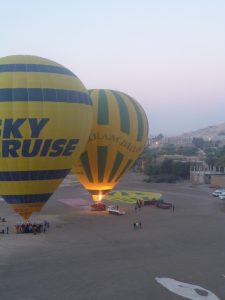
The first thing I heard when I woke up this morning was the news that eighteen tourists have died after the hot air balloon they were riding in crashed near Luxor in Egypt. It’s an awful, tragic accident and my heart goes out to those – mostly in Hong Kong but also in Japan and the UK – who had family or friends on board.
It seems that a gas cylinder exploded at an altitude of around a thousand feet, causing the balloon to catch fire and fall into the fields below. According to reports, just one passenger and the pilot have survived.
This story touched me particularly because I rode in one of these balloons last February, while I was visiting Luxor for book research. Details surrounding the accident are scarce, so I thought it might be of interest to write something about these balloons, and what the flight involves.
Each morning just after dawn, scores of these colourful balloons float serenely above the fields, just across the Nile from the city of Luxor. I watched them at breakfast each day and it seemed the perfect way to get my head around how this dramatic landscape is laid out, so I arranged the trip through my hotel, a little locally-owned place called Hotel Marsam.
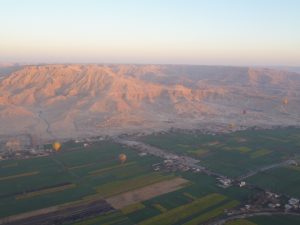
A minibus picked me up in the blackness of 5am, and took me, plus a group of women on a girls’ trip from Sydney, to a field where other minibuses were congregating, and dozens of huge balloons were laid on their sides, gradually being filled and raised off the ground. As far as I could tell, each balloon is privately owned, just like the taxis, and the little motorboats that ferry tourists back and forth across the Nile.
We were bustled into our balloon just as the sun started to peep orange over the horizon. The basket was divided into four with around six tourists squashed into each quarter, and the single pilot in a separate compartment in the middle. He gave a quick safety drill – how to brace ourselves low against the wall of the basket for landing – and we were away, almost the first balloon to leave the ground. The view was one of the most beautiful things I’ve ever seen. As the rising sun lit up the valley, other balloons rose like bubbles from the dramatic landscape beneath us.
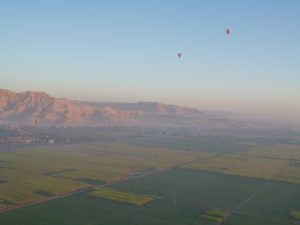
At the centre of it all is the Nile, running south to north, bordered on each side by a fertile green strip of fields. A couple of miles out from the river, there’s a sudden change to dry, amber sand. This soon rises into the rocky hills of the desert, which then stretches all the way to the sea.
On the river’s east bank is the modern city of Luxor. But it’s the ancient ruins that tourists pile into these precarious baskets to see. Luxor is on the site of the ancient city of Thebes, seat of power of the Egypt’s pharaohs between the 11th and 16th centuries BC. The East Bank was for the living, the site of residential areas and temples. The West Bank was for the dead, its foothills speckled with tombs. Hidden behind the cliffs is the famous Valley of the Kings, where the pharaohs of this period – including Tutankhamun – were laid to rest.
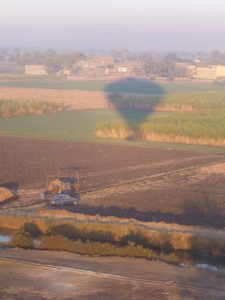
Dotted along the line between green and amber – the boundary between the living and the dead – we could see the ruins of memorial temples, where the ancient Egyptians went to pay respect to the spirits of their dead kings.
The wind carried us south for about half an hour, then we started to descend over clusters of roughly-built mud houses – roofless structures with everything from laundry to cows packed into the rooms inside. Then, as we sailed low over fields of wheat and sugarcane, the pilot shouted “We’re going too fast!” followed by “Get down! Get down!”
We all braced ourselves in terror as several rough bumps on the ground took us what felt like thirty feet in the air, before we finally skidded to a halt with the basket on its side. I don’t know if our pilot really was worried, or if our landing was normal and he put on a dramatic show to ensure that we took his instructions seriously. But after we landed, he looked just as relieved as I felt.
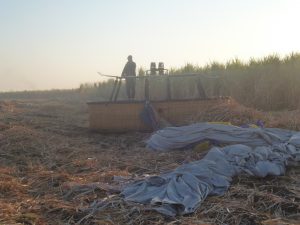
After hearing about today’s crash, I feel even luckier than I did then. I don’t know how these balloon operators are regulated in terms of safety. Apparently they were shut down for six months in 2009, after sixteen tourists were injured in a crash, while security measures were tightened up. I imagine it’ll take more than that to restore confidence this time round.
But I hope this disaster doesn’t deter tourists from visiting this incredibly beautiful part of the world. Tourism hasn’t recovered since visitors were scared off during the uprising of January 2011, yet Luxor itself did not see violence or looting. When I visited in February 2012, it was quiet and peaceful – a unique opportunity to see the awesome archaeological sites without having to push through the crowds (I had Tutankhamun’s tomb to myself, for example).
And if you want an aerial view of the Valley, you don’t have to go up in a balloon. Go to the Valley of the Kings and walk to its eastern edge. From there it’s an easy scramble up the pebbly slope to the top of the ridge. Walk over to the opposite side and hold your breath as the entire expanse of the Valley opens out in front of you – a stunning view that has barely changed in three thousand years.

Leave a Reply